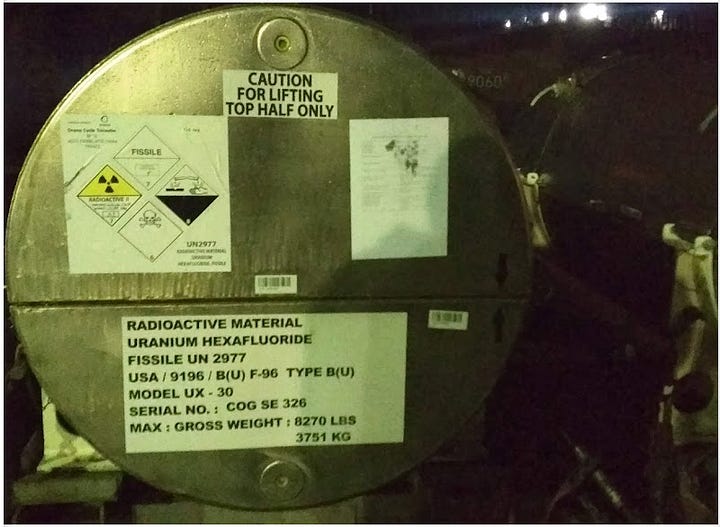Procurement documentation provides details of vulnerability analysis for nuclear materials transportation in Russia
National-level DBT has not been updated for four years. TENEX faces problems with identifying contractors. Level of effort is estimated at 304 hours.
TENEX announced the procurement but failed to find a contractor.
In September 2024, TENEX, Rosatom’s foreign trade subsidiary, announced the procurement of services to conduct vulnerability analysis (VA) and evaluation of the effectiveness (EE) of physical protection for standard intersite transportation of nuclear materials. TENEX received only one proposal and eventually canceled the procurement in November because the identified contractor, a private Russian company with substantial experience in developing physical protection systems for nuclear sites, could not extend its license on time to implement this work. No new procurement has been publicly announced since then.
Published procurement documentation identifies requirements for VA and EE procedures.
Still, published contract documentation provides insight into details of the practical implementation of VA and EE for the transportation of nuclear materials in Russia. VA and EE are key processes in designing, maintaining, and operating nuclear security systems. VA implies the determination of vulnerable points of the nuclear site or transport, threats to nuclear materials, and consequences of malign actions. VA serves as a basis for designing a protection system. Effectiveness evaluation (EE) is a process aimed at evaluating the effectiveness of a protection system, i.e., its ability to protect nuclear material against the threat determined during VA. Russian regulations require the conduct of VA and EE for nuclear sites and the transportation of nuclear materials regularly.
Statement of Work for VA and EE defines transportation routes for which VA and EE must be provided. These routes include railroad and road vehicle transportation between the TENEX logistics hub near St. Petersburg, several seaports around St. Petersburg, and the port of Nakhodka in the Russian Far East, presumably used to ship low-enriched uranium, Ulba Metallurgical Plant in Kazakhstan hosting the IAEA nuclear fuel bank and manufacturing fuel pellets and assemblies, and the St.Petersburg Nuclear Physics Institute (PNPI). VA and EE are required for primary and backup options for several routes. For other routes, only a single option must be considered.


The Statement of Work also defines the VA and EE procedure requirements and expected deliverables. Work objectives include:
determining ways of threat realization during nuclear material (NM) transportation under a given adversary model;
identifying vulnerabilities of vehicles involved in NM transportation;
determining potentially dangerous locations along transportation routes;
determining the nature and category of potential consequences of unauthorized actions against transported NM;
evaluating the effectiveness of physical protection during NM transportation, including assessment of the physical protection system's ability to prevent unauthorized access to the protected item;
considering scenarios of possible adversary actions, calculating effectiveness indicators according to the adopted criterion - prevention of unauthorized actions;
developing reporting documents.
The process should include the following steps:
collection of necessary information for vulnerability analysis, document review, interviewing TENEX experts, visual inspection of vehicles and transportation routes (if necessary);
description of geographical characteristics and description of routes, vehicles, transported nuclear material, and transport packaging sets;
determination of types and characteristics of possible threats to objects of physical protection and vehicles, methods of their realization;
identification and description of vulnerabilities, compilation of a list of physical protection items;
determination of authority of persons involved in nuclear material transportation;
description of social and economic situation along the transportation route;
determination of threats and methods of their realization for vehicles;
determination of adversary model;
preparation of source data for EE based on VA results;
calculating physical protection system effectiveness indicators;
analysis of obtained results.
EE report must include scenarios of potential adversary actions, including outsiders and insiders acting separately and in collusion, and recommendations to improve physical protection during transportation if deficiencies are identified.
These requirements are mostly copied and pasted from the regulations defining requirements for VA and EE. The SOW contains a list of regulations defining requirements for the procedure and results. Most of these documents are publicly available. There are two “for official use only” Rosatom documents establishing detailed procedures for VA and EE. These Rosatom documents were developed with US funding and technical support within the US-Russia nuclear security cooperation framework.
National-level DBT has not been updated for four years.
Another document referred to in the SOW that is not publicly available is the FSB’s “List of Basic Threats to Nuclear and Radiation Hazard Sites and Standard Adversary Models,” approved on December 8, 2020. These “basic threats” and “standard adversary models” constitute the national-level Design Basis Threat (DBT), which nuclear sites must use as a starting point when developing site-specific DBT during VA. The issue date suggests that the national DBT was not updated for four years.
The level of effort for VA and EE is estimated at 304 hours.
Another notable piece of information provided in the SOW is the evaluation of the level of effort and costs of VA and EE. According to the SOW, VA and EE require the work of the team lead and two experts for a total of 304 hours (around 100 hours each). The hourly salary for all team members is 767 rubles ($8.30 as of the publication date). The total contract amount is 1234260,82 rubles ($13356,36 as of the publication date), which, in addition to salary and a 10% employee bonus, includes overhead, “general production cost,” 20% profit, and VAT.
I am looking for a job and would appreciate your help. In the meantime, you can buy me a coffee if you want to support my work on this newsletter.

